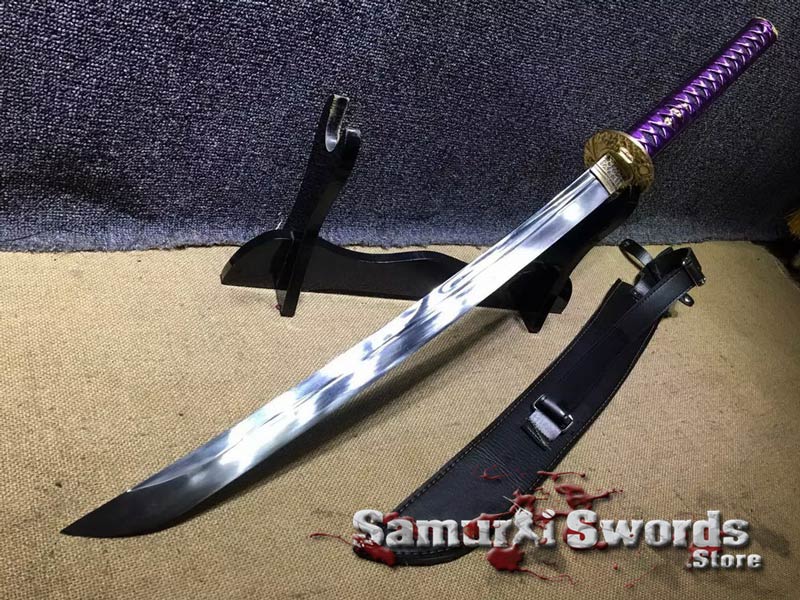Naginata Blade 1060 Carbon Steel With Synthetic Leather Holsters Saya
1060 Carbon Steel Naginata Blade Full Tang And Fully Sharpened With Synthetic Leather Holsters Saya, Brass Fitting And Black Ray Skin Samegawa With Synthetic Purple Leather Wrap
Sword Type: Naginata
Steel Type: 1060 Carbon Steel
Blade Length: 50 Centimeters
Handle Length: 35 Centimeters
Blade Width: 3.2 Centimeters
Weight: 1.6KG
Tang: Full Tang
Sharpness: Fully Sharpened
Blood Groove: With Bohi (Blood Groove)
Tsuba (Handguard): Brass Tsuba
Fuchi (Hilt Collar): Brass Fuchi
Kashira (Pommel): Brass Kashira
Menuki (Handle Ornaments): Metal Menuki
Saya (Scabbard): Synthetic Leather Holsters Saya
Ito (Wrap): Synthetic Purple Leather
Ray Skin (Samegawa): Black Ray Skin
Sword Bag: N/A
Naginata Blade
The Naginata is considered as a polearm and its design was patterned after the Chinese weapon called the Pu Dao; it often measures over two meters in length and was first utilized in battle during the eighth century. It was primarily used to dismount cavalrymen while simultaneously being a very efficient weapon when it comes to clearing foot soldiers; soon, the Naginata also became a favored weapon among the Samurais. However, when we speak of our version of the Naginata, these are made with the traditional blade without the long staff that supposedly comes along with the weapon. Our Naginata may not feature the famous long wooden handle but its blade is still as durable, sharp, and highly efficient, making it fully functional for slashing, chopping, and great for practice sessions.
Based on historical facts, it is said that the Naginata have been utilized in China right at the beginning of 3 B.C. and has also been represented in various paintings of war scenes created during the Tengyo Insurrection in 936 A.D. The weapon was used and processed around 710 to 784 B.C. during the Nara period while it was widely utilized in battle during the eleventh century. Moreover, the Naginata was also utilized by warrior-monks as a weapon to protect and defend their temples against invaders; yet at some point in the 1400 A.D. the monks stopped using the weapon since their temples were no longer assaulted by invaders. When it came to the Samurais, they only utilized this weapon when battling against a large number of enemies or when they were on horseback.
More on the history of the traditional Naginata, it was also commonly used by apprentice Samurais who still had difficulties or were too young to wield a full length katana, yet by the end of the Edo era which lasted from 1603 to 1867, the Naginatas were no longer utilized in combat but were used as weapons to represent the samurai women. These skilled females engaged in various training for self-defense to protect their children, as well as to further develop their virtue and strength. Moreover, the Naginatas were also used for decorative purposes since samurai families made use of these weapons and displayed them in the most prominent places of their houses; there was also a time when it was given as a present to brides.
Even without the long pole, our Naginata is a full-tang weapon that features blood grooves on both sides to make the blade lighter, and its cutting edge has been sharpened to perfection to make it fully functional and perfect for practice, drills, or even target cutting (the Tamashigiri). The blade is made from authentic and quality 1060 steel that has been heat tempered to produce a longer lasting and more durable weapon. This Naginata blade measures a total of fifty centimeters in length while its width is at 3.2 centimeters; when it comes to its heaviness, the Naginata weighs a total of 1.6 kilograms.
Aside from a fully functional and highly efficient blade, our Naginata features a strong and sturdy grip that has a total length of thirty-five centimeters; it has a stylish black colored ray skin that is wrapped in a very elegant looking synthetic purple leather. Our Naginata also has a crossguard, fuchi, as well as a kashira made from top-notch brass plus it also features beautiful metallic ornaments with a scabbard made of synthetic leather holsters.

